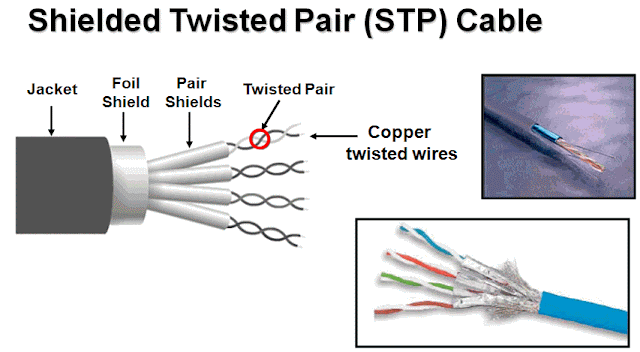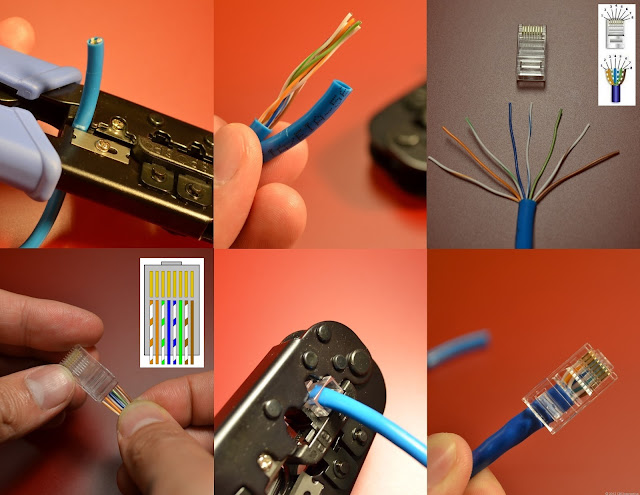What is Network Cabling?
Cable is the medium through which information usually moves from one network device to another. There are several types of cable which are commonly used with LANs. In some cases, a network will utilize only one type of cable, other networks will use a variety of cable types. The type of cable chosen for a network is related to the network's topology, protocol, and size. Understanding the characteristics of different types of cable and how they relate to other aspects of a network is necessary for the development of a successful network.
The following sections discuss the types of cables used in networks and other related topics.
- Unshielded Twisted Pair (UTP) Cable
- Shielded Twisted Pair (STP) Cable
- Coaxial Cable
- Fiber Optic Cable
Twisted Pair Cables
Two primary types of twisted pair cable industry standards are defined – Unshielded Twisted Pair (UTP) and Shielded Twisted Pair (STP).
UTP Cable
Unshielded Twisted Pair (UTP) cable is most certainly by far the most popular cable around the world. UTP cable is used not only for networking but also for the traditional telephone (UTP-Cat 1). There are seven different types of UTP categories and, depending on what you want to achieve, you would need the appropriate type of cable. UTP-CAT5e is the most popular UTP cable which came to replace the old coaxial cable that was not able to keep up with the constant growing need for faster and more reliable networks.
 UTP Cat6UTP Cat5e
UTP Cat6UTP Cat5e
The characteristics of UTP are very good and make it easy to work with, install, expand and troubleshoot and we are going to look at the different wiring schemes available for UTP, how to create a straight through UTP cable, rules for safe operation and a lot of other cool stuff !So let's have a quick look at each of the UTP categories available today along with their specifications:
STP Cable
Shielded twisted pair is a special kind of copper telephone wiring used in some business installations. An outer covering or shield is added to the ordinary twisted pair telephone wires; the shield functions as a ground.
Twist Pair Connector
The RJ45 connector works with twisted pair cabling and is the most common type of connector in modern networks. In addition, the RJ45 connector is used on Cisco console cables.
There are four colors associated with the eight wires within the cable. The colors of the wires determine where they will be terminated in the RJ45 connector. The color code is Blue, Orange, Green, and Brown. For each color, there are two types: "Color + White" & "White + Color". In other words, there are two blue wires – One is mostly blue with white stripes, the other is mostly white with blue stripes. These are referred to as White/Blue & Blue/White.
There are three types of cables you must be familiar with for the CCNA Blueprint: Straight Cable, Crossover Cable, and Rollover Cable. These cable types are determined by where the various colored wires are terminated (installed) within the RJ45 connector.
Straight Cable:
In a straight cable (also called a straight through) cable, the wires are terminated on the same RJ45 pins at both sides of the cable:
Key Topic: A straight cable is used to connect devices that operate at different layers of the OSI Model. For example, a straight cable is used to connect a switch (L2) to a router (L3).
Crossover Cable:
In a crossover cable, four wires are reversed or crossed. Pins 1,2,3,6 on the left are terminated on 3,6,1,2 on the right respectively:
Key Topic: A crossover cable is used to connect two devices that operate on the same layers of the OSI Model. For example, a crossover cable is used to connect a router to another router.
Rollover Cable (AKA Rolled Cable):
A rolled cable is 100% reversed on one side of the cable:
Key Topic: A rolled cable is used to connect to the console port on a Cisco network device (switch / router / etc…).
Coaxial Cables
A type of wire that consists of a center wire surrounded by insulation and then a grounded shield of braided wire. The shield minimizes electrical and radio frequency interference.
Coaxial cabling is the primary type of cabling used by the cable television industry and is also widely used for computer networks, such as Ethernet. Although more expensive than standard telephone wire, it is much less susceptible to interference and can carry much more data.
Coaxial Cable Connectors
The most common type of connector used with coaxial cables is the Bayone-Neill-Concelman (BNC) connector. Different types of adapters are available for BNC connectors, including a T-connector, barrel connector, and terminator. Connectors on the cable are the weakest points in any network. To help avoid problems with your network, always use the BNC connectors that crimp, rather screw, onto the cable.
Fiber Optic Cable
A technology that uses glass (or plastic) threads (fibers) to transmit data. A fiber optic cable consists of a bundle of glass threads, each of which is capable of transmitting messages modulated onto light waves.
Fiber optics has several advantages over traditional metal communications lines:






















0 comments:
Post a Comment